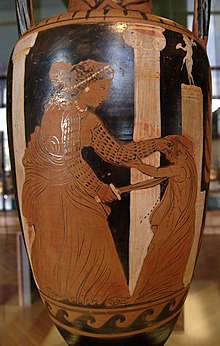Campanian vase painting


The Campanian vase painting was one of the five regional styles of Lower Italian - red-figure vase painting . Together with Apulian ceramics , it formed a closer stylistic community.
In Campania in the 5th and 4th centuries BC. Produced red-figure vases. On the sand-colored to light brown clay of Campania, it was lighter than the other clays of southern Italy, a thin coating was applied, which after firing takes on a pink to red hue and comes very close to that of the Attic vases . The popular light opaque colors also worked particularly well on it. Women are often characterized by the application of white paint to the areas of their skin. Campanian vase painters preferred rather smaller types of vessels, with hydration and bell craters added . As a leading form of Campania which applies Bügelhenkelamphora . Many vessel shapes that were typical of Apulian pottery were missing, such as volute and colonic craters , lutrophores , rhyta and nestorids ; Peliks are rare. The motivic repertoire is limited. On display are figures of young men and women, Thiasos scenes, pictures of birds and animals, and above all local and Samnite warriors and women. Often there are cloak boys on the back . Mythological scenes and depictions related to the grave cult play a subordinate role than in Apulia, for example. Naiskos scenes , ornamental elements and polychromy are only used from around 340 BC. Taken up under Apulian influence. The bell-shaped flowers on the vessels are very different from the ornaments of the other sub-Italian styles. With 4,000 known examples, the Campanian is the second largest style of Lower Italian ceramics after the Apulian.
From the time before the immigration of Sicilian ceramists in the second quarter of the 4th century BC BC, who established several workshops in Campania, there is only the workshop of the Owl-Pillar group from the second half of the 5th century BC. Known. She imitated Attic red-figure models. Campania vase painting is divided into three main groups:

The first group is represented by the workshop of the Kassandra painter from Capua , who was still under the influence of Sicilian painters, especially the chessboard painter . This is followed by the workshops of the Parrish painter and the workshop of the Laghetto painter and the Caivano painter , which was influenced by Paestan painters. Large-format vases in the workshops were mostly decorated with mythological images. Characteristic are the preference for Satyrfiguren with Thyrsos , representations of heads - usually below the handles of hydriai -, tin border white on the robes and the frequent use, red and yellow additional color. The Laghetto and Caivano painters appear to have emigrated to Paestum later . The last representative of the manufactory was the Ixion painter .
The AV group and the Capua painter also had their workshop in Capua. This manufactory was apparently founded by immigrants from Sicily. The Whiteface Frignano painter , who was one of the first painters of the group, is particularly important here . Typical for him is the use of additional white color to mark female faces. Local scenes, women and warriors were shown especially in this group. Multi-figure scenes are rare, usually only one figure is shown on the front and back, sometimes only the head. The robes are mostly sketchy.
The workshop in Cumae was founded very late. Worked here after 350 BC. The workshop founder, the CA painter , as well as his employees and successors. The CA painter is considered to be an outstanding representative of this group, possibly of all Campanian vase painting. From 330 BC A strong influence of Apulian vase painting is evident. The most common motifs are naiskos and grave scenes, Dionysian scenes and symposium representations. The depiction of decorated women's heads is also typical. The CA painter worked in polychrome, but sometimes used a lot of opaque white in depictions of architecture and women. His successors, the CB painter and the CC painter , were only able to maintain its quality to a limited extent, and a decline quickly set in, which began around 300 BC. In the end of the Campanian vase painting.
literature
- Arthur D. Trendall : The red-figured vases of Lucania, Campania and Sicily. 2 volumes. Clarendon Press, Oxford 1967.
- Arthur D. Trendall: The red-figured vases of Lucania, Campania and Sicily. (= University of London. Institute of Classical Studies. Bulletin. Supplement. Vol. 41). Supplement 3. University of London - Institute of Classical Studies, London 1983, ISBN 0-900587-44-X .
- Arthur D. Trendall: Red-figure vases from southern Italy and Sicily. A manual (= cultural history of the ancient world . Vol. 47). von Zabern, Mainz 1991, ISBN 3-8053-1111-7 , especially pp. 178-222.
- Rolf Hurschmann : Campanian vase painting. In: The New Pauly (DNP). Volume 6, Metzler, Stuttgart 1999, ISBN 3-476-01476-2 , column 227 f.
- Thomas Mannack : Greek vase painting. An introduction. Theiss, Stuttgart 2002, ISBN 3-8062-1743-2 , p. 165 f.
Web links
Individual evidence
- ^ Hurschmann: Campanian vase painting. In: DNP. Vol. 6, 1998, Col. 227.